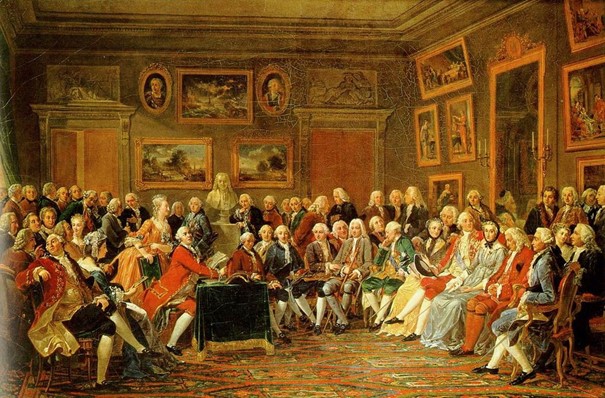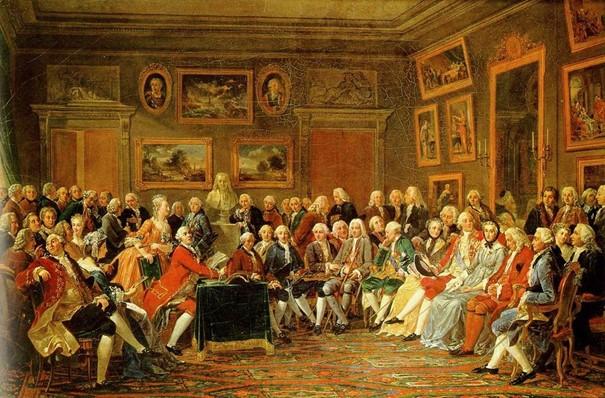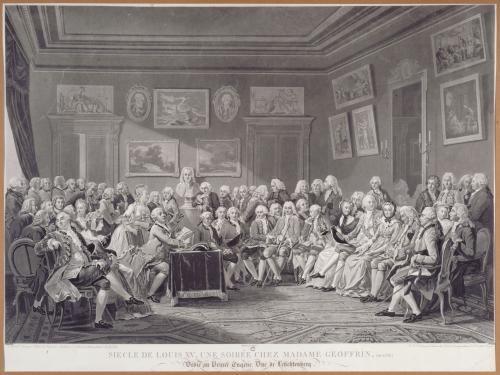Résumé
The salon is one of the most recognizable practices of sociability of the French Enlightenment. While scholars continue to debate the relationship of the salons to the Enlightenment, the salons were nevertheless a defining feature of social life in the Ancien Régime, with hundreds of salons taking place throughout Paris. These weekly gatherings featured a mixed-gendered group of aristocrats, artists, and men of letters. The salons were social gatherings, involving conversation and games, but they were also sites for literary and philosophical discussion, and notably, for men of letters to network and secure protections and patronage.
Mots-clés
The salon is one of the most recognizable practices of sociability of the French Enlightenment, even if the gatherings were not designated by the term ‘salon’ until the nineteenth century.1 A pillar of French literary, philosophical, and aristocratic culture throughout the Ancien Régime, the practice has its origins in the elite society of seventeenth-century France.
- 1. See the definition of ‘Salon’ in Dictionnaire de l'Académie française, 6th Edition (1835): ‘Il s'emploie figurément, surtout au pluriel, pour désigner, La bonne compagnie, les gens du beau monde.’
In the seventeenth century, although many elite women hosted worldly gatherings that included the presence of writers and poets, like the vicomtesse d’Auchy or Madame des Loges, the ‘first’ salon, in the tradition that we recognize today as constituting this practice of sociability, is commonly attributed to Catherine de Vivonne, marquise de Rambouillet. The gatherings at the hôtel Rambouillet over the course of forty years in the first half of the seventeenth century became the ‘archetype of French aristocratic sociability’.2 As Joan DeJean notes, ‘whereas most European nations at one time or another knew some degree of salon activity […] only in France did salons flourish without interruption for nearly two centuries.’3 Receiving her guests in her bedchamber, known by her guests as la chambre bleue, the marquise de Rambouillet would stay in bed and seat her guests in between the bed and wall – the space referred to as the ruelle. While this behavior was perhaps idiosyncratic, it established a casual, intimate, and familiar tone for the practice of sociability, which would also characterize the gatherings held by Madeleine de Scudéry in the Marais, and other précieuses like Madame de Sévigné or Madame de Lafayette. (DeJean 378-379)
- 2. Benedetta Craveri, The Age of Conversation, trans. Teresa Waugh (New York: New York Review Books, 2001), p. xi.
- 3. Joan DeJean, ‘Rooms of their Own: Literary Salons in Seventeenth-Century France,’ in Glyn P. Norton (ed.) The Cambridge History of Literary Criticism, III: The Renaissance (Cambridge: Cambridge University Press, 1999), p. 378.
The art of refined conversation was at the core of these gatherings hosted by elite French women. Individuals amused themselves with witty word games like ‘rigmaroles’, which made composing rhymed verse into a collective activity. (Craveri 60) The salons were also sites for débuting early versions of new works, whether fairytales by Marie-Catherine d’Aulnoy, Polyeucte by Pierre Corneille, or La Princesse de Montpensier by Madame de Lafayette.4 In addition, a defining feature was the stability of the core group attending the salons on a weekly basis, which included most major writers of the time. Scholars claim this regular meeting of individuals, with an array of opinions and ideas, contributed to the development of a collective literary taste and the practice of informal literary criticism. Guests would exchange ideas and comment on the new works that writers would try out in the salons. As DeJean puts it, ‘At no other time in the history of French culture has literary criticism been so thoroughly integrated into the daily life’ of the social elite. (DeJean 383)
- 4. Angus Fletcher, Wonderworks: The 25 Most Powerful Inventions in the History of Literature (New York: Simon & Schuster, 2021), p. 108-109; Anne-Marie Feat, ‘Playing the Game of Frivolity: Seventeenth-Century “Conteuses” and the Transformation of Female Identity’, The Journal of the Midwest Modern Language Association (vol. 45, n° 2, 2012), p. 217–42, p. 217; DeJean, p. 379-380.
These foundational seventeenth-century salons have in some respects been overshadowed by those of the Enlightenment. The vision that many have of salons in the age of Enlightenment is best memorialized by Anicet Charles Gabriel Lemonnier’s tableau in 1812.

This painting depicts a fictionalized scene of a reading of Voltaire’s tragedy L’Orpheline de la Chine that took place in 1755. In the tableau, all of the famous Enlightenment thinkers – Marivaux, Marmontel, Rousseau, Turgot, Malesherbes, Montesquieu, Helvétius, Buffon, and Diderot, to name a few – are gathered in an ornate drawing room to debate the newest literary works and philosophical ideas, and to discuss the political issues of the day. While many of the attendees depicted did in fact attend Geoffrin’s salon at one time or another, many did not, and they were never all present at the same time.5 In reality, salon gatherings included a vast range of activities, including sharing literary works to be sure, but also featuring a breadth of activities with little relation whatsoever to the project of Enlightenment.
- 5. Antoine Lilti, Le monde des salons: Sociabilité et mondanité à Paris au XVIIIe siècle (Paris: Fayard, 2005) p. 15-16.
There were hundreds of salons taking place throughout Paris in the eighteenth century. In the broadest of terms, and not unlike those of the seventeenth century, a salon in eighteenth-century France was a weekly gathering that frequently offered supper, often hosted by an elite woman, but sometimes hosted by a man – such as the salon hosted by the baron d’Holbach. As Morellet describes it, in the case of Madame Geoffrin’s salon, the gens de lettres 's’accoutumèrent à se rassembler chez elle un jour de la semaine; le mercredi elle leur donnoit à diner.'6 The typical demographic profile of a salon host was a wealthy individual of prominent status in le monde (Parisian high society). Salons were invite-only, but once an invitation was secured, an attendee could consider it an open invitation for the future. (Lilti 69)
- 6. André Morellet, Antoine-Léonard Thomas, and d’Alembert, Éloges de Madame Geoffrin, contemporaine de Mme Du Deffand, par MM. Morellet, Thomas et d’Alembert, suivis de lettres de Mme Geoffrin et à Mme Geoffrin, et d’un Essai sur la conversation, etc., etc., par M. Morellet (Paris: H. Nicolle, 1812), p. 56.
The financial burden of hosting such a salon was significant, and indeed proved an obstacle to many despite their close ties with philosophical networks, as was the case for Madame d’Épinay and Françoise de Graffigny. (Lilti 93-98, 177) Some salon hostesses found a means to circumnavigate this financial challenge. Julie de Lespinasse, for instance, received visitors every day for four hours, and rather than offering supper, people would stop by after supper or before other engagements.7
- 7. Keith M. Baker, Condorcet, from Natural Philosophy to Social Mathematics (Chicago: Chicago University Press, 1975), p.17.
Salons would also often include various genres of entertainment, such as theater, gambling, oral readings of new literary texts or recently received letters, and of course, extensive conversation.8 Madame Du Deffand frequently read the letters she received from Voltaire to the guests gathered at her salon.9 As for the conversation at Lespinasse’s salon, Grimm observed, ‘politique, religion, philosophie, contes, nouvelles, rien n’était exclu de ses entretiens’.10
Above and beyond the allure of the salons’ divertissements, the salons were critical milieus of social networking. Salons were defined by the membership of both men and women, and brought together in one place gens de lettres and gens du monde, including aristocrats, high-ranking government officials, men of letters, and artists. (Lilti 66) Grimm described Julie de Lespinasse’s salon according to the following, ‘Son cercle se renouvelait tous les jours, depuis cinq heures jusqu’à neuf heures du soir. On était sûr d’y trouver des hommes choisis de tous les ordres de l’Etat, de l’Eglise, de la cour, des militaires, les étrangers et les gens de lettres les plus distingués.’ (Grimm 263) The salons provided a place where the interests of both men of letters and aristocrats could converge. In Elena Russo’s words, ‘Salonnières played the role of cultural mediators and brokers between artists and writers, on the one hand, and the public of wealthy amateurs and government officials who controlled the state-sponsored institutions of letters’.11 Salons were key sites for men of letters to secure protections and patronage from influential aristocrats, vie for official positions, and even campaign for election to the academies. At Madame Geoffrin’s Monday salon for artists, ‘Les gens du monde admis dans cette société, y connoissoient les artistes personnellement, et se déterminoient plus aisément à mettre leurs talens en œuvre’, noted Morellet (57). As Keith Baker has shown, Lespinasse’s salon functioned as an ‘antechamber’ to the French Academy, where the philosophes could strategically select candidates and campaign for their election; indeed, from 1767 to 1776, eight philosophes were elected to the French Academy, all regular attendees of Lespinasse’s salon whom d’Alembert had groomed. (Baker 18-23)
- 8. Chloe Summers Edmondson, ‘Julie de Lespinasse and the “philosophical” salon’, in Chloe Edmondson and Dan Edelstein (eds.) Networks of Enlightenment: Digital Approaches to the Republic of Letters (Liverpool: Liverpool University Press, Oxford University Studies in the Enlightenment, 2019), p. 139.
- 9. Jacqueline Hellegouarc’h in Voltaire, Voltaire: Correspondance choisie (Paris: Le Livre de poche, 1997), p. 929, note 8.
- 10. Friedrich Melchior Grimm, Correspondance littéraire, philosophique et critique par Grimm, Diderot, Raynal, Meister, etc., (ed.) Maurice Tourneux, vol.11 (Paris, 1879), p. 264.
- 11. Elena Russo, Styles of Enlightenment: Taste, Politics, and Authorship in Eighteenth-Century France (Baltimore: The Johns Hopkins Press, 2007), p. 63.
The women and men whose salons are most well-known today due to their social influence in eighteenth-century France each deserve their own dedicated article – and each has been the subject of many studies. Madame Tencin’s and Madame du Deffand’s salons represent some of the earlier salons of the Enlightenment, hosting men of letters such as Fontenelle, Montesquieu, and Marmontel. Madame Geoffrin made her mark with her salon on two different days of the week – Mondays for artists and Wednesdays for gens de lettres.12 Julie de Lespinasse was what we would call today an ‘apprentice’ of Madame du Deffand as her companion for many years, before founding her own salon on the rue Saint-Dominique where many of Deffand’s attendees followed her. Lespinasse’s salon is also known for its close ties with d’Alembert, given their friendship and the fact that they co-habitated, which rendered her salon a homebase for the encyclopédistes.13 D’Holbach’s salon and coterie, perhaps most closely associated with the more radical ideas of the French Enlightenment, was the most famous salon hosted by a man.14 Madame Necker’s salon immediately conjures political associations because of her husband, Jacques Necker, and one can only assume that her daughter Madame de Staël learned all she needed to from her mother for her own salon rue du Bac, and then at the Château de Coppet.15
The salons soared to prominence amongst scholarly debates following Jürgen Habermas’ influential work The Structural Transformation of the Public Sphere, which highlighted the importance of institutions of sociability – and the salons in particular – for the birth of public opinion in the eighteenth century.16 Since then, historians have continued to probe the true role of the salons, especially in their relation to the Enlightenment. Some scholars have portrayed the salons as egalitarian and democratic milieus where individuals first learned to exercise their reason to critique literature and art, followed by the critique of politics.17 To others, the salons were feminist spaces governed by women, where men and women collaborated together to produce and diffuse knowledge of the Enlightenment.18 The extent to which the salons actually were indispensable to the intellectual ideas of the Enlightenment, and the degree to which relations in the salons were egalitarian, has been challenged by cultural historians, who remind us that these salons were defined by the hierarchical and aristocratic society of which these salons were cornerstones. According to this view, the salons were first and foremost elite spaces of aristocratic activity for gaining access to le monde, in other words, to protections and patronage, rather than philosophical engines of the Republic of Letters. (Lilti 173-175)
- 12. See Melanie Conroy and Chloe S. Edmondson, ‘The Empire of Letters: Enlightenment-Era French Salons’, in Simon Burrows and Glenn Roe (eds.) Digitizing Enlightenment: Digital Humanities and the Transformation of Eighteenth-Century Studies, (Liverpool: Liverpool University Press, 2020).
- 13. Janine Bouissounouse, Julie de Lespinasse: ses amitiés, sa passion (Paris, 1958), p. 80; Baker, p. 16-17.
- 14. See Alan Charles Kors, D’Holbach’s Coterie: an Enlightenment in Paris (Princeton: Princeton University Press, 1976).
- 15. Etienne Hofmann and François Rosset, Le groupe de Coppet: une constellation d’intellectuels européens, (Lausanne: Presses polytechniques et universitaires romandes, 2005).
- 16. Jürgen Habermas, The Structural transformation of the public sphere: an inquiry into a category of bourgeois society (Cambridge: The MIT Press, 1989), p. 27.
- 17. See Daniel Gordon, Citizens without sovereignty: equality and sociability in French thought, 1670-1789 (Princeton: Princeton University Press, 1994).
- 18. Dena Goodman, The Republic of letters: a cultural history of the French Enlightenment (Ithaca: Cornell University Press,1994), p. 9-11.
These diverging scholarly accounts remind us of the sheer scope and magnitude of different types of salons in eighteenth-century France. The salons, as a primary practice of sociability in the daily life of high society, were defined by the aristocratic nature of life in the Ancien Régime. But the salons were in some ways an amalgamation of the many features that scholars highlight today. Salons were spaces of entertainment, gambling, games, and suppers, spaces of networking, spaces for sharing new literary works, and spaces for conversation. And, recent studies have shown that the demographic backgrounds of attendees point to distinctions between salons, revealing that some were more associated with the court, some more integrated with the academies, and some more philosophical and more closely linked to the encyclopédistes.19
- 19. See Conroy and Edmondson, ‘The Empire of Letters: Enlightenment-Era French Salons’; see also Edmondson, ‘Julie de Lespinasse and the ‘philosophical’ salon’, Chloe Edmondson and Dan Edelstein (eds.) in Networks of Enlightenment: Digital Approaches to the Republic of Letters, (Liverpool: Liverpool University Press, Oxford University Studies in the Enlightenment, 2019).
The salons, in fact, could not have existed without both the aristocrats, with access to power and prestige, and the philosophes, who were defining the intellectual agenda of the Enlightenment. Some salons failed precisely because they had not enough of either group. (Lilti 177) Moreover, many of the female salon hostesses who maintained prominent salons over the years proved how critical a role they played in facilitating the connections between the gens de monde and gens de lettres, since without them – it seems – these networks very often did not survive. Evidence suggests that the deaths of Julie de Lespinasse and Madame Geoffrin, for instance, were ‘followed by a relative vanishing of the philosophical salons’, causing a disruption to the community of intellectuals in Paris whereby some philosophes also ceased to attend other salons.20
The French Revolution brought an abrupt end to the practices of sociability of the society of the Ancien Régime. And yet, some salon activity continued despite the Revolution. Take for instance Madame de Staël’s cosmopolitan salon of the European intelligentsia and émigrés at the Château de Coppet in Switzerland, or the salons that endeavored to resurrect the tradition in Paris in the first half of the nineteenth century hosted by Madame de Genlis at the Arsenal, or Delphine de Girardin, whose salon was regularly frequented by Balzac, Musset, and Hugo. The ethos of the tradition continues to manifest glimmers in educated circles to this day, with individuals dubbing various gatherings of any sort a ‘salon’, if the group of invités bears an interest in literature or the world of ideas.
- 20. See Charlotta Wolff, ‘“Un admirateur des philosophes modernes”: the networks of Swedish ambassador Gustav Philip Creutz in Paris, 1766-1783’ in Chloe Edmondson and Dan Edelstein (eds.) Networks of Enlightenment: Digital Approaches to the Republic of Letters, (Liverpool: Voltaire Foundation in association with Liverpool University Press, 2019), p. 198.
Partager
Références complémentaires
Landes, Joan, Women and the Public Sphere in the Age of the French Revolution (Ithaca: Cornell University Press, 1988).
Lougee, Carolyn, Le Paradis des Femmes: Women Salons, and Social Stratification in Seventeenth-Century France (Princeton: Princeton University Press, 1996).
Beasley, Faith E., Salons, History, and the Creation of 17th-Century France: Mastering Memory (Aldershot: Ashgate Publishing Company, 2006).
Kale, Steven, French Salons: High Society and Political Sociability from the Old Regime to the Revolution of 1848 (Baltimore: The Johns Hopkins University Press, 2004).

